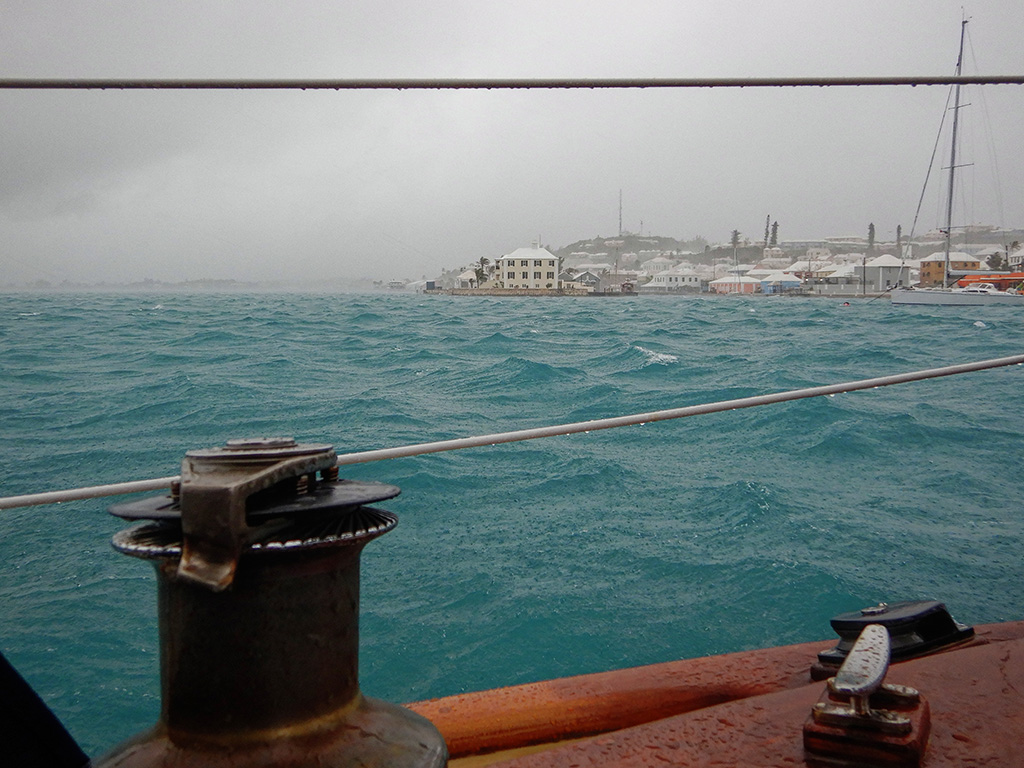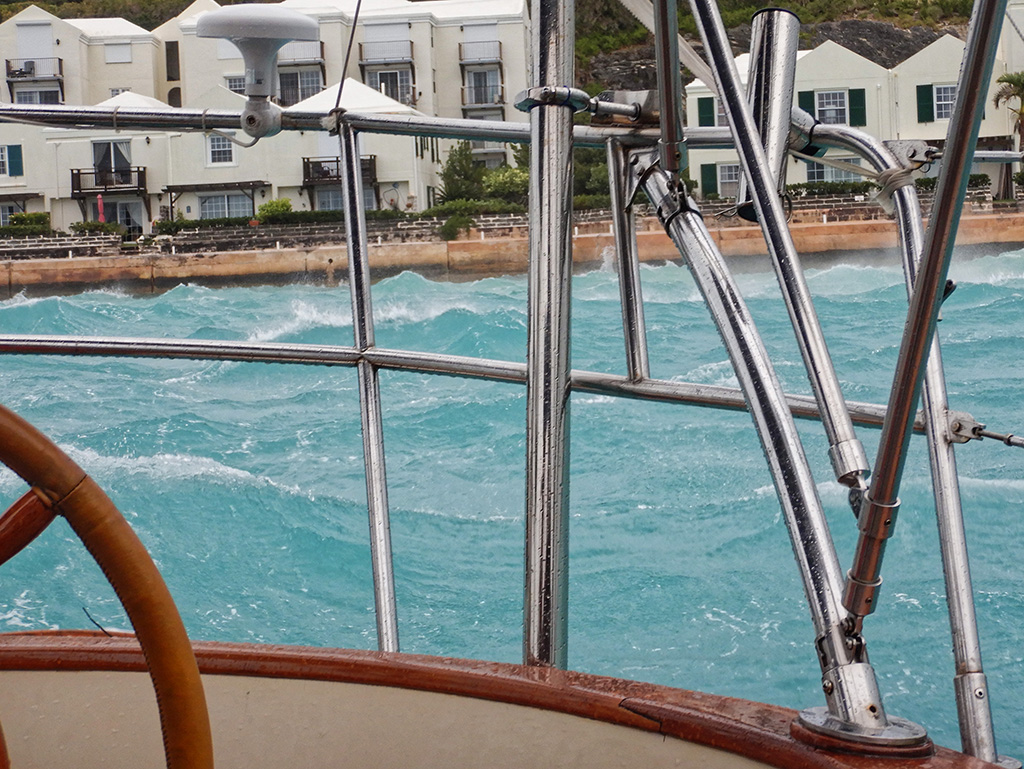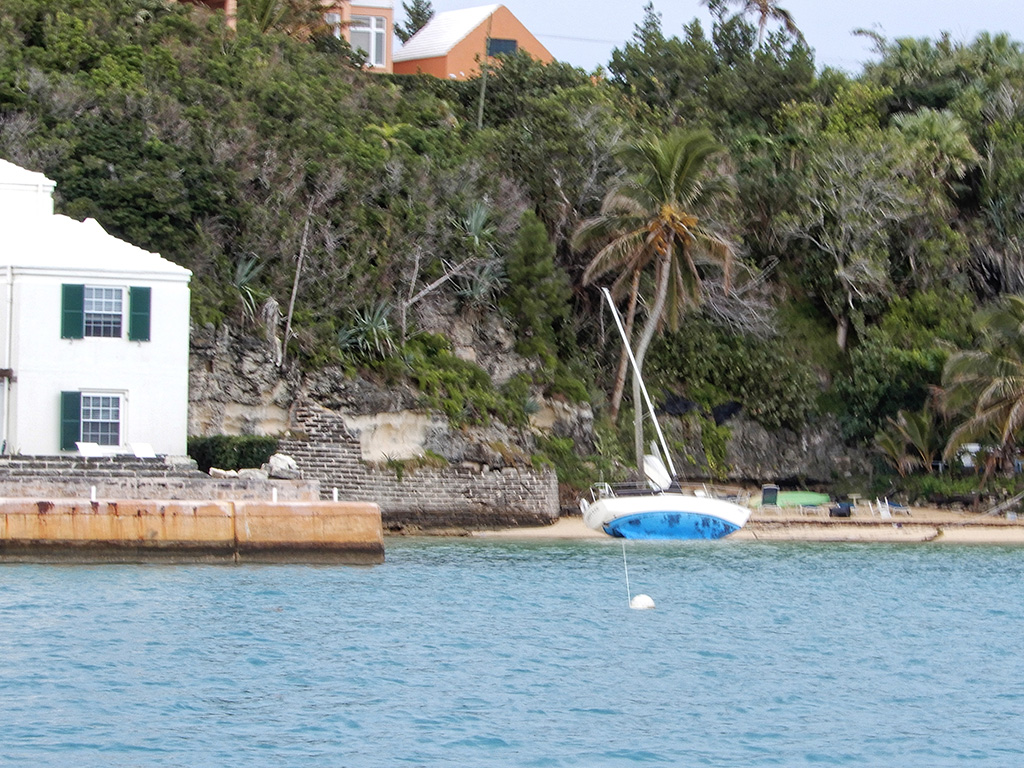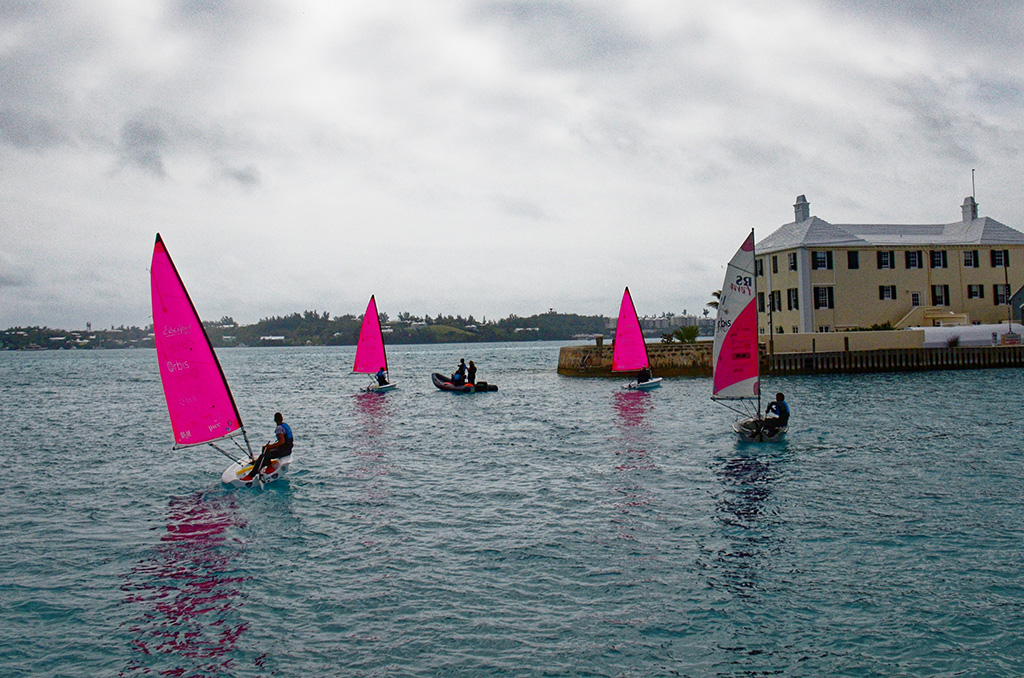It was Friday, January 13th, 2023. Yes, Friday the 13th. I’m not superstitious. Why should I be? I am not a Knight Templar!
When I returned to Bermuda a couple of weeks ago, I sailed through The Town Cut into Convict Bay. With a broken propellor shaft, the anchor was set under sail alone. I was not able to back down on the anchor with the engine. Backwinding the sails was all I could do to set the anchor firmly.
Yesterday was a beautifully calm day. No wind at all! I had gone ashore and picked up snacks. The weather forecast predicted a significant change. There was going to be a winter gale! Bermuda Weather Service warned me that a Bermuda winter gale can be as bad as a hurricane. I was about to experience my first.
The anchor was holding well. I did not want to move the boat under sail alone, to a location that was better protected. That would mean it was well protected from the winds. Winds that were needed to set the anchor again.
Storm Preparation
I chose to stay put in Convict Bay. My main concern was the 40-50 kn winds and the resulting waves that would develop.
Right now, the winds were very light… from the southwest. Once the winds backed to the south, the weather would change quickly and build to a gale and then, possibly a full storm
In preparation, I brought my backup anchor on deck and prepared it to launch. I did the same with my emergency anchor. On the primary anchor, I let out an additional 30’ of chain. There was now 150′ of chain out. Distant Horizon was anchored in 18′ of water.
I rested the best I could while waiting for the wind to change. I will have to be alert once the winds begin to build. If my anchor started to drag, I would have to react quickly. There was a boat moored about 100 feet behind me. A blue Steel boat named Hayat.

Hayat Moored Close Behind Distant Horizon
The large white boat, Baraka, was moored to my northwest. A man was aboard that boat. He was checking his mooring lines as I was checking my anchor line. We waved briefly. It was comforting to know someone else was going to ride out the storm as well. I knew, if things got terrible, we would not be able to help each other. It was reassuring to know he was there.

Baraka and Hayat Moored behind Distant Horizon
By evening, nothing had changed. I made a large pot of pasta with a variety of beans. It’s something easy to make and provides carbohydrates and protein in stressful times. It does not need to be refrigerated. I put it in the pressure cooker. The locking lid keeps it from spilling in rough seas. The pressure cooker is placed in the oven for safekeeping. On a marine stove, the oven door locks in the closed position.

Convict Bay Looking towards St. George
The Gale
I slept soundly for a while, but the howling wind woke me up. I went outside. Protected from the wind by the dodger, I made a visual check of my surroundings.
The dodger is a little canvas cover that protects the companionway hatch from wind, rain, and spray. It has windows. It is literally a windshield since the boat always points into the wind when on a mooring or at anchor. Under the dodger is a protected space.
The boat was pointing south! The winter gale has begun. I took bearings on objects located on land to I could quickly tell my position. On the chart plotter, I placed a waypoint at my position so I had a GPS reference point. I did the same on the navigation software on my phone. On the phone, I also placed a measurement marker from the boat to land behind me… 348 feet. This marker will stay locked to the boat and the position I set on land. So, I see the distance with just a quick glance and know if the boat has moved… if the anchor was dragging.
At this time, the wind was just 22-24 kts… no worries. Still, I was up all night maintaining an anchor watch. I was wearing my foul weather gear, ready to go on deck if need be even in the worst rains.
I napped in the cockpit under the dodger with a blanket on me.
Nearly all morning, the winds were in the mid-20s, gusting to a little over 30 kts. Around 11 am, I noticed the gusts were getting higher; to the upper 30s. Now the winds were more steady between 28-30 kts.
Everything still looked good.
The winds were continually building. An hour later, the steady winds were in the low 40s and gusts to over 50 kts.
I called Bermuda Radio on the VHF radio. I wanted to know what the winds up there were. This way, I could compare the forecast to their readings and mine down in the harbor. They were happy to share the information and logged my observations. Bermuda radio had steady 52-55 kts winds gusting to 65 kts. I thought this was it. We are in the worst of the storm. Their readings were consistent with the forecasted winds.
.I was wrong. By 2:30 that afternoon, I was reading steady winds around 52kts and 62 kts gusts
Now, I was concerned about the anchor’s ability to hold the boat in these winds. In hurricanes and bad storms, people put out two and three anchors. I had just one. I have never been in a storm like this before.
Two Anchors
In hindsight, I thought I should have placed my secondary anchor out using my tender. Then, I would have two anchors holding the boat. I don’t like two anchors. In the past, I’ve had bad experiences with them getting tangled, even though they were set 45 degrees apart from each other.
I dropped my secondary anchor in place. It was nowhere near the other anchor or its chain at this time. If I started dragging, I would let the chain and rope of the second anchor out… that was the plan.
55-knot winds gusting to 65 knots seemed to peak between 2:30 and 3 pm. By 3:30, I noticed the boat had moved.
According to the forecast, the wind would veer to the southwest and begin to ease.
Anchor Dragging
There are still a couple of boat lengths from the boat that was moored behind me. Distant Horizon was not dragging her anchor enough to be visually perceptible. I could only tell from the GPS position on the chartplotter and phone. She had moved about 15 feet. I thought maybe the wind had pushed the boat enough to fully stretch the chain and everything was alright.

Winter Gale – Looking back hoping land didn’t get any closer
Keeping a close eye on land-based objects to fix my position, I could not see any movement, a little while later, I had moved another 10 feet. Distant Horizon was dragging her anchor very slowly.
I let more line out on the second anchor. It was not enough to set that anchor though.
My tender was tied to the back of the boat. It is 8 feet long and about two lengths from the mooring ball behind me. I inflated my fenders and secured one to the side of my boat. If I dragged back to that boat, I did not want to damage it. He had fenders on his deck. So, with mine, and pulling his over the side, I could hopefully keep the two boats apart.
At this point, I was out of plans and options. Not knowing what else I could do, I called the man on Baraka using the VHF radio. I explained what I had done and asked if he had any other ideas.
He said, at all costs, to keep the two boats apart. Then suggested I pull in bout 10 feet of chain if I could. He said at my rate of drift, that may buy me the time I needed for the winds to veer.
Pulling chain in with a dragging anchor is contrary to conventional thinking. It took me a minute to grasp. He was not talking about stopping the anchor from dragging. He was talking about mitigating the risk of a collision by creating more space, and therefore more time… I got! Like hockey… I had to think about time and space, not setting the anchor…
I went on deck. There was way too much tension for me to pull the 30,000 lb boat against 50 kn winds. I noticed that when the boat pitched up from the waves, a little slack developed in the chain when the boat came back down. There seemed to be a cycle of three… the first time it pitched, there was only a little slack. The next time, there was a little more, and finally the third time, a fair amount of slack.
I tried on every third pitch to pull all the slack I could. By that time, the boat pitched down far enough that water would spray up over the bow… and subsequently my head. I was gaining 8-10 inches at a time. So, I tried to get a little on the second pitch and immediately get more on the third. I could gain about a foot this way. However, every few attempts timed it wrong and lost 6 inches.
After two hours, I was exhausted. The spray from the water ran down my head, down my back, and inside the foul weather gear. I was soaked!
I stopped to return to the cockpit and see how I was situated. Then, I went below to drink some water.
At that time, I was keeping up with the dragging anchor. The tender was about one length from the mooring ball… losing 8 feet in two hours was a win in my mind. But, I knew I was still losing ground. I went back to the bow to bring in more chain…
I continued as best I could. The boat pitched less. So, the work was harder. Every muscle in my body was shouting at me. It was 5:40 pm. I knew the wind shift should have come by now. It had not!
Winds Beginning to Ease
It was 6 pm. The wind was blowing hard, the sky was cloudy, and very little light remained in the sky. The waves suddenly seemed to be smaller. So, the wind at the other end of the harbor had lessened. This gave me more hope, and strength as I pulled on the chain.
I turned around and took a quick glance. The boat that was behind me was off to my starboard side… a little. The wind was veering. I walked back and saw my tender had not reached the mooring ball. The mooring ball was about 30 feet from the boat. I was cautiously optimistic.
The wind continued to veer. So I maintained watch in the cockpit all night again… under the dodger and a blanket.
No more drama that night! By morning, the winds were calm.
Post-Storm Tasks
At 5:30 am, I was on deck getting the anchor lines sorted out. First, to keep Distant Horizon from drifting sideways into the other boat, I took my emergency anchor in my tender and set it about 150’ south of my boat. This would hold me in place when I bring the other two anchors back onboard. It would also cause me to swing a little farther from that other boat.
The sun came up around 7:30 am. I discovered the chain links from the secondary anchor had wrapped and interlocked with the primary anchor’s chain. I had most probably caused the dragging by dropping the secondary anchor and leaving slack in the line to accommodate dragging if it had occurred. This was a tough lesson to learn.

A Sailboat Broke off its Mooring during the storm and ended up on the beach… better than the rocks!
I spent a couple of hours getting the chain separated and bringing in the anchor line. Finally, one of the sailing instructors, Tom, was returning in his zodiac. He had his jib, which had gotten free during the storm. It was damaged and needed repair. With his help and use of the zodiac, we were able to get the chains separated.
Although the chains were separated, neither anchor would come up. I don’t think Distant Horizon would have dragged any further. It took the zodiac pulling Distant Horizon forward over the anchors to get them free. It actually took 3 or 4 attempts to free the anchors.
Once both anchors were on board, I prepared the primary anchor to be deployed. My plan was to put the anchor in my tender and row it out to a location where I wanted to drop it.
With the anchor and chain in the tender, I quickly learned the force from the chain’s weight took a lot of rowing to overcome. Tom gave me his bow line and slowly pulled the tender into position. With his help, I was able to drop the anchor exactly where I thought I would be safe.
The next task was to retrieve the emergency anchor. That went without a hitch. There is no chain on that anchor. Finally, I tied the bow line of Tom’s zodiac to the stern of Distant Horizon. Tom backed down until my anchor set solid.
The sun was shining with a clear blue sky. The water was calm. Distant Horizon was safe and secure. I was thankful for the advice from Baraka, Tom’s help, and my hard work to prevent a collision with the other boat.
I asked Tom what I owed him for his help. He looked and said, “Nothing, At times of need boaters should help each other”.
In Bermuda, every middle school child gets sailing lessons along with boat handling lessons on the zodiacs. It’s a not-for-profit organization. Tom is one of the instructors. I told him that I would donate to their organization (Endeavour), then… but I still owe him a beer. He said, “A beer, I will accept.”

Endeavour!

Yes, the prop shaft is fixed. I am taking the bus to see land-based locations… Monday, I will go to the crystal caves and finish with a stop at the Swizzle Inn. Yesterday I hiked part of the railroad trail near the flats and visited the aquarium. For 12 square miles, there really is a lot to see. I am helping a man who is writing a cruising guide by visiting the anchorages around the island. It’s great to have a local explain ways to reach very isolated locations… and of course… varnish 🙂
That island gets pretty small after a week what are you doing? Prop shaft fixed yet?